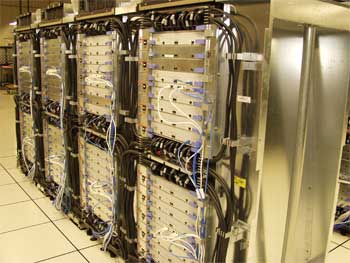IBM continues to dominate the list of the world’s fastest supercomputers, holding 4 positions in the Top 10 supercomputers and more than half of the Top 500 supercomputers worldwide.
 |
|
Blue Gene Supercomputer System |
In addition to Intel’s x86 technology, the number of supercomputers running Advanced Micro Devices (AMD) processors is also gaining more positions in the Top 500 list of the world’s fastest supercomputers.
The latest Top 500 supercomputers list was announced yesterday (June 28) at the International Supercomputing Conference held in Germany. This list is the result of a collaborative project between the University of Mannheim (Germany), the University of Tennessee, and the National Energy Research Scientific Computing Center at Lawrence Berkeley National Laboratory.
IBM continues to hold the top position on the list with its Blue Gene/L supercomputer system installed at the Energy Research Laboratory of Lawrence Livermore National Laboratory.
This supercomputer system has achieved a Linpack performance index with a processing speed of up to 280.6 teraflops, equivalent to 280.6 trillion calculations per second. Meanwhile, no supercomputer in the Top 500 list surpassed the 100 teraflops mark. This is why experts believe that IBM’s supercomputers will continue to dominate the Top 500 list of the fastest supercomputers in the foreseeable future.
IBM’s supercomputers account for 48.6% of the entire Top 500 list. Hewlett-Packard holds the second position with about 30.8%. Sun Microsystems has returned to the Top 10 at the 7th position thanks to servers running on Opteron processors located at the GSIC Center of the Tokyo Institute of Technology.
A total of 24 of IBM’s Blue Gene supercomputer systems are included in the Top 500 list.
According to the organizers of the Top 500 list, while “overthrows” at the bottom of the rankings do not occur frequently, the competition for leading positions in the top is very intense. Three positions in the Top 10 from the list published in November 2005 have been replaced.
Intel’s processor products — Xeon and Itanium chips — are used in 301 supercomputer systems in this Top 500 list. Meanwhile, Intel’s competitor AMD can be pleased as the number of supercomputers running its Opteron processors has increased from 25 last year to 81 this year. IBM’s Power processors are utilized in 84 supercomputers on this year’s list.
The smallest supercomputer in this year’s list has achieved a speed of 2.03 teraflops, up from 1.17 teraflops last year.
Hoang Dung


















































